Antioxidant Effects of Carnosine-Enriched Chicken Meat Consumption in Athletes: Modulation of SOD Activity and Superoxide Levels—A Randomized Control Trial
Abstract
1. Introduction
2. Materials and Methods
2.1. Study Design and Participants
2.2. Sampling and Anthropometric Measurements
2.3. Antioxidative Enzyme Activity
2.4. Flow Cytometry
2.5. Enzyme-Linked Immunosorbent Assay (ELISA)
2.6. Luminex Assay
2.7. Statistical Analysis
3. Results
3.1. General Characteristics, Anthropometric and Biochemical Parameters of Study Participants
3.2. CAT, GPx, and SOD Serum Activity
3.3. Hydrogen Peroxide, Peroxynitrite, and Superoxide Anion Intracellular Production in PBMCs
3.4. Serum Concentration of 8-iso Prostaglandin F2α (8-iso PGF 2α)
3.5. Serum Cell Adhesion Molecules Concentration
4. Discussion
5. Conclusions
Author Contributions
Funding
Institutional Review Board Statement
Informed Consent Statement
Data Availability Statement
Acknowledgments
Conflicts of Interest
References
- Granato, D.; Barba, F.J.; Bursać Kovačević, D.; Lorenzo, J.M.; Cruz, A.G.; Putnik, P. Functional Foods: Product Development, Technological Trends, Efficacy Testing, and Safety. Annu. Rev. Food Sci. Technol. 2020, 11, 93–118. [Google Scholar] [CrossRef]
- Essa, M.M.; Bishir, M.; Bhat, A.; Chidambaram, S.B.; Al-Balushi, B.; Hamdan, H.; Govindarajan, N.; Freidland, R.P.; Qoronfleh, M.W. Functional Foods and Their Impact on Health. J. Food Sci. Technol. 2023, 60, 820–834. [Google Scholar] [CrossRef] [PubMed]
- Hasler, C.M. Functional Foods: Benefits, Concerns and Challenges—A Position Paper from the American Council on Science and Health. J. Nutr. 2002, 132, 3772–3781. [Google Scholar] [CrossRef]
- Lobo, V.; Patil, A.; Phatak, A.; Chandra, N. Free Radicals, Antioxidants and Functional Foods: Impact on Human Health. Pharmacogn. Rev. 2010, 4, 118–126. [Google Scholar] [CrossRef]
- Tkaczenko, H.; Kurhaluk, N. Antioxidant-Rich Functional Foods and Exercise: Unlocking Metabolic Health Through Nrf2 and Related Pathways. Int. J. Mol. Sci. 2025, 26, 1098. [Google Scholar] [CrossRef]
- Damián, M.R.; Cortes-Perez, N.G.; Quintana, E.T.; Ortiz-Moreno, A.; Garfias Noguez, C.; Cruceño-Casarrubias, C.E.; Sánchez Pardo, M.E.; Bermúdez-Humarán, L.G. Functional Foods, Nutraceuticals and Probiotics: A Focus on Human Health. Microorganisms 2022, 10, 1065. [Google Scholar] [CrossRef]
- Cencic, A.; Chingwaru, W. The Role of Functional Foods, Nutraceuticals, and Food Supplements in Intestinal Health. Nutrients 2010, 2, 611–625. [Google Scholar] [CrossRef] [PubMed]
- Nasri, H.; Baradaran, A.; Shirzad, H.; Rafieian-Kopaei, M. New Concepts in Nutraceuticals as Alternative for Pharmaceuticals. Int. J. Prev. Med. 2014, 5, 1487–1499. [Google Scholar] [PubMed]
- Venkatakrishnan, K.; Chiu, H.-F.; Wang, C.-K. Extensive Review of Popular Functional Foods and Nutraceuticals against Obesity and Its Related Complications with a Special Focus on Randomized Clinical Trials. Food Funct. 2019, 10, 2313–2329. [Google Scholar] [CrossRef]
- Perić, L.; Drenjančević, I.; Jukić, I.; Boris, A.; Šušnjara, P.; Kolobarić, N.; Mihaljević, Z.; Kralik, Z.; Kralik, G.; Košević, M.; et al. Carnosine-Enriched Functional Food Enhances Micro- and Macrovascular Endothelium-Independent Vasodilation in Competitive Athletes-a Randomized Study. Appl. Physiol. Nutr. Metab. 2025, 50, 1–11. [Google Scholar] [CrossRef]
- Kolobarić, N.; Gradinjan Centner, M.; Šušnjara, P.; Matić, A.; Drenjančević, I. Anthropometric and Biochemical Parameters in Relation to Dietary Habits as Early Indicator of Cardiovascular Impairment in Young Adult Cohort. Int. J. Environ. Res. Public. Health 2020, 17, 9208. [Google Scholar] [CrossRef]
- Jukić, I.; Kolobarić, N.; Stupin, A.; Matić, A.; Kozina, N.; Mihaljević, Z.; Mihalj, M.; Šušnjara, P.; Stupin, M.; Ćurić, Ž.B.; et al. Carnosine, Small but Mighty—Prospect of Use as Functional Ingredient for Functional Food Formulation. Antioxidants 2021, 10, 1037. [Google Scholar] [CrossRef]
- Torreggiani, A.; Tamba, M.; Fini, G. Binding of Copper(II) to Carnosine: Raman and IR Spectroscopic Study. Biopolymers 2000, 57, 149–159. [Google Scholar] [CrossRef]
- Xing, L.; Chee, M.E.; Zhang, H.; Zhang, W.; Mine, Y. Carnosine—A Natural Bioactive Dipeptide: Bioaccessibility, Bioavailability and Health Benefits. J. Food Bioact. 2019, 5, 8–17. [Google Scholar] [CrossRef]
- Chasovnikova, L.V.; Formazyuk, V.E.; Sergienko, V.I.; Boldyrev, A.A.; Severin, S.E. The Antioxidative Properties of Carnosine and Other Drugs. Biochem. Int. 1990, 20, 1097–1103. [Google Scholar]
- Cao, Y.; Xu, J.; Cui, D.; Liu, L.; Zhang, S.; Shen, B.; Wu, Y.; Zhang, Q. Protective Effect of Carnosine on Hydrogen Peroxide-Induced Oxidative Stress in Human Kidney Tubular Epithelial Cells. Biochem. Biophys. Res. Commun. 2021, 534, 576–582. [Google Scholar] [CrossRef] [PubMed]
- Caruso, G.; Fresta, C.G.; Musso, N.; Giambirtone, M.; Grasso, M.; Spampinato, S.F.; Merlo, S.; Drago, F.; Lazzarino, G.; Sortino, M.A.; et al. Carnosine Prevents Aβ-Induced Oxidative Stress and Inflammation in Microglial Cells: A Key Role of TGF-Β1. Cells 2019, 8, 64. [Google Scholar] [CrossRef]
- Caruso, G.; Fresta, C.G.; Fidilio, A.; O’Donnell, F.; Musso, N.; Lazzarino, G.; Grasso, M.; Amorini, A.M.; Tascedda, F.; Bucolo, C.; et al. Carnosine Decreases PMA-Induced Oxidative Stress and Inflammation in Murine Macrophages. Antioxidants 2019, 8, 281. [Google Scholar] [CrossRef] [PubMed]
- Li, X.; Gu, X.; Li, X.; Yan, J.; Mao, X.; Yu, Q.; Du, Y.; Kurihara, H.; Yan, C.-Y.; Li, W. Supplementation with Carnosine, a Food-Derived Bioactive Dipeptide, Alleviates Dexamethasone-Induced Oxidative Stress and Bone Impairment via the NRF2 Signaling Pathway. J. Sci. Food Agric. 2025, 105, 1091–1104. [Google Scholar] [CrossRef]
- Drenjančević, I.; Stupin, A.; Jukić, I.; Kolobarić, N.; Šušnjara, P.; Kozina, N.; Kovač, L.; Mihaljević, Z. Oral Carnosine Supplementation Preserves Vascular Function of Sprague Dawley Rats on a High-Salt Diet via Restored Antioxidative Defence. Nutrients 2025, 17, 36. [Google Scholar] [CrossRef] [PubMed]
- Park, H.-S.; Han, K.-H.; Shin, J.-A.; Park, J.-H.; Song, K.-Y.; Kim, D.-H. The Neuroprotective Effects of Carnosine in Early Stage of Focal Ischemia Rodent Model. J. Korean Neurosurg. Soc. 2014, 55, 125–130. [Google Scholar] [CrossRef]
- Dodson, M.; Castro-Portuguez, R.; Zhang, D.D. NRF2 Plays a Critical Role in Mitigating Lipid Peroxidation and Ferroptosis. Redox Biol. 2019, 23, 101107. [Google Scholar] [CrossRef]
- Lu, M.-C.; Ji, J.-A.; Jiang, Z.-Y.; You, Q.-D. The Keap1-Nrf2-ARE Pathway as a Potential Preventive and Therapeutic Target: An Update. Med. Res. Rev. 2016, 36, 924–963. [Google Scholar] [CrossRef]
- He, H.; Lv, C.; Xie, Y.; Li, W.; Ling, Z.; Cheng, B.; Tao, X. Carnosine Alleviates Oxidative Stress to Prevent Cellular Senescence by Regulating Nrf2/HO-1 Pathway: A Promising Anti-Aging Strategy for Oral Mucosa. Front. Pharmacol. 2025, 16, 1559584. [Google Scholar] [CrossRef] [PubMed]
- Solana-Manrique, C.; Sanz, F.J.; Martínez-Carrión, G.; Paricio, N. Antioxidant and Neuroprotective Effects of Carnosine: Therapeutic Implications in Neurodegenerative Diseases. Antioxidants 2022, 11, 848. [Google Scholar] [CrossRef] [PubMed]
- Hamouda, M.H.; Salem, H.F.; Afifi, H.E.L.D.M.; Ibrahim, N.A.; Rabea, H. Effect of Carnosine Supplementation as Add-On Therapy with Vitamin B Complex in People With Type 2 Diabetes and Diabetic Neuropathy: A Randomized Controlled Study. Clin. Diabetes 2024, 42, 561–569. [Google Scholar] [CrossRef] [PubMed]
- Saadati, S.; de Courten, M.; Deceneux, C.; Plebanski, M.; Scott, D.; Mesinovic, J.; Jansons, P.; Aldini, G.; Cameron, J.; Feehan, J.; et al. Carnosine Supplementation Has No Effect on Inflammatory Markers in Adults with Prediabetes and Type 2 Diabetes: A Randomised Controlled Trial. Nutrients 2024, 16, 3900. [Google Scholar] [CrossRef]
- Hariharan, R.; Cameron, J.; Menon, K.; Mesinovic, J.; Jansons, P.; Scott, D.; Lu, Z.X.; de Courten, M.; Feehan, J.; de Courten, B. Carnosine Supplementation Improves Glucose Control in Adults with Pre-Diabetes and Type 2 Diabetes: A Randomised Controlled Trial. Nutr. Metab. Cardiovasc. Dis. 2024, 34, 485–496. [Google Scholar] [CrossRef]
- de Courten, B.; Jakubova, M.; de Courten, M.P.; Kukurova, I.J.; Vallova, S.; Krumpolec, P.; Valkovic, L.; Kurdiova, T.; Garzon, D.; Barbaresi, S.; et al. Effects of Carnosine Supplementation on Glucose Metabolism: Pilot Clinical Trial. Obesity 2016, 24, 1027–1034. [Google Scholar] [CrossRef]
- O’Toole, T.E.; Amraotkar, A.R.; Gao, H.; Sears, C.G.; Rai, S.N.; Basner, M.; Bhatnagar, A. Carnosine Supplementation Improves Cognitive Outcomes in Younger Participants of the NEAT Trial. Neurotherapeutics 2025, 22, e00541. [Google Scholar] [CrossRef]
- Slowinska-Lisowska, M.; Zembron-Lacny, A.; Rynkiewicz, M.; Rynkiewicz, T.; Kopec, W. Influence of L-Carnosine on pro-Antioxidant Status in Elite Kayakers and Canoeists. Acta Physiol. Hung. 2014, 101, 461–470. [Google Scholar] [CrossRef]
- Kolobarić, N.; Drenjančević, I.; Matić, A.; Šušnjara, P.; Mihaljević, Z.; Mihalj, M. Dietary Intake of N-3 PUFA-Enriched Hen Eggs Changes Inflammatory Markers’ Concentration and Treg/Th17 Cells Distribution in Blood of Young Healthy Adults—A Randomised Study. Nutrients 2021, 13, 1851. [Google Scholar] [CrossRef] [PubMed]
- Cosic, A.; Jukic, I.; Stupin, A.; Mihalj, M.; Mihaljevic, Z.; Novak, S.; Vukovic, R.; Drenjancevic, I. Attenuated Flow-Induced Dilatation of Middle Cerebral Arteries Is Related to Increased Vascular Oxidative Stress in Rats on a Short-Term High Salt Diet. J. Physiol. 2016, 594, 4917–4931. [Google Scholar] [CrossRef]
- Aebi, H. Catalase in Vitro. Methods Enzymol. 1984, 105, 121–126. [Google Scholar] [CrossRef]
- Flohé, L.; Otting, F. Superoxide Dismutase Assays. Methods Enzymol. 1984, 105, 93–104. [Google Scholar] [CrossRef]
- Wendel, A. Glutathione Peroxidase. Methods Enzymol. 1981, 77, 325–333. [Google Scholar] [CrossRef]
- Barić, L.; Drenjančević, I.; Mihalj, M.; Matić, A.; Stupin, M.; Kolar, L.; Mihaljević, Z.; Mrakovčić-Šutić, I.; Šerić, V.; Stupin, A. Enhanced Antioxidative Defense by Vitamins C and E Consumption Prevents 7-Day High-Salt Diet-Induced Microvascular Endothelial Function Impairment in Young Healthy Individuals. J. Clin. Med. 2020, 9, 843. [Google Scholar] [CrossRef]
- Kolar, L.; Šušnjara, P.; Stupin, M.; Stupin, A.; Jukić, I.; Mihaljević, Z.; Kolobarić, N.; Bebek, I.; Nejašmić, D.; Lovrić, M.; et al. Enhanced Microvascular Adaptation to Acute Physical Stress and Reduced Oxidative Stress in Male Athletes Who Consumed Chicken Eggs Enriched with N-3 Polyunsaturated Fatty Acids and Antioxidants-Randomized Clinical Trial. Life 2023, 13, 2140. [Google Scholar] [CrossRef] [PubMed]
- Kang, J.H.; Kim, K.S.; Choi, S.Y.; Kwon, H.Y.; Won, M.H.; Kang, T.-C. Protective Effects of Carnosine, Homocarnosine and Anserine against Peroxyl Radical-Mediated Cu,Zn-Superoxide Dismutase Modification. Biochim. Biophys. Acta 2002, 1570, 89–96. [Google Scholar] [CrossRef] [PubMed]
- Stvolinskii, S.L.; Fedorova, T.N.; Yuneva, M.O.; Boldyrev, A.A. Protective Effect of Carnosine on Cu,Zn-Superoxide Dismutase during Impaired Oxidative Metabolism in the Brain in Vivo. Bull. Exp. Biol. Med. 2003, 135, 130–132. [Google Scholar] [CrossRef] [PubMed]
- Decker, E.A.; Faraji, H. Inhibition of Lipid Oxidation by Carnosine. J. Am. Oil Chem. Soc. 1990, 67, 650–652. [Google Scholar] [CrossRef]
- Xiao, S.; Zhuang, H.; Zhou, G.; Zhang, J. Investigation of Inhibition of Lipid Oxidation by L-Carnosine Using an Oxidized-Myoglobin-Mediated Washed Fish Muscle System. LWT 2018, 97, 703–710. [Google Scholar] [CrossRef]
- Fresta, C.G.; Hogard, M.L.; Caruso, G.; Costa, E.E.M.; Lazzarino, G.; Lunte, S.M. Monitoring Carnosine Uptake by RAW 264.7 Macrophage Cells Using Microchip Electrophoresis with Fluorescence Detection. Anal. Methods 2017, 9, 402–408. [Google Scholar] [CrossRef] [PubMed]
- Kim, M.Y.; Kim, E.J.; Kim, Y.-N.; Choi, C.; Lee, B.-H. Effects of α-Lipoic Acid and L-Carnosine Supplementation on Antioxidant Activities and Lipid Profiles in Rats. Nutr. Res. Pract. 2011, 5, 421–428. [Google Scholar] [CrossRef]
- Fresta, C.G.; Fidilio, A.; Lazzarino, G.; Musso, N.; Grasso, M.; Merlo, S.; Amorini, A.M.; Bucolo, C.; Tavazzi, B.; Lazzarino, G.; et al. Modulation of Pro-Oxidant and Pro-Inflammatory Activities of M1 Macrophages by the Natural Dipeptide Carnosine. Int. J. Mol. Sci. 2020, 21, 776. [Google Scholar] [CrossRef]
- Alpsoy, L.; Akcayoglu, G.; Sahin, H. Anti-Oxidative and Anti-Genotoxic Effects of Carnosine on Human Lymphocyte Culture. Hum. Exp. Toxicol. 2011, 30, 1979–1985. [Google Scholar] [CrossRef] [PubMed]
- Andrés, C.M.C.; Pérez de la Lastra, J.M.; Andrés Juan, C.; Plou, F.J.; Pérez-Lebeña, E. Superoxide Anion Chemistry—Its Role at the Core of the Innate Immunity. Int. J. Mol. Sci. 2023, 24, 1841. [Google Scholar] [CrossRef] [PubMed]
- Fridovich, I. Superoxide Radical and Superoxide Dismutases. In Proceedings of the Oxygen and Living Processes; Gilbert, D.L., Ed.; Springer: New York, NY, USA, 1981; pp. 250–272. [Google Scholar]
- Shields, H.J.; Traa, A.; Van Raamsdonk, J.M. Beneficial and Detrimental Effects of Reactive Oxygen Species on Lifespan: A Comprehensive Review of Comparative and Experimental Studies. Front. Cell Dev. Biol. 2021, 9, 628157. [Google Scholar] [CrossRef]
- Dawson, R.; Biasetti, M.; Messina, S.; Dominy, J. The Cytoprotective Role of Taurine in Exercise-Induced Muscle Injury. Amino Acids 2002, 22, 309–324. [Google Scholar] [CrossRef]
- Spriet, L.L. Performance Nutrition for Athletes. Sports Med. 2019, 49, 1–2. [Google Scholar] [CrossRef]
- Sale, C.; Artioli, G.G.; Gualano, B.; Saunders, B.; Hobson, R.M.; Harris, R.C. Carnosine: From Exercise Performance to Health. Amino Acids 2013, 44, 1477–1491. [Google Scholar] [CrossRef] [PubMed]
- Mikuła-Pietrasik, J.; Książek, K. L-Carnosine Prevents the Pro-Cancerogenic Activity of Senescent Peritoneal Mesothelium Towards Ovarian Cancer Cells. Anticancer Res. 2016, 36, 665–671. [Google Scholar] [PubMed]
- Wu, C.-C.; Lai, P.-Y.; Hsieh, S.; Cheng, C.-C.; Hsieh, S.-L. Suppression of Carnosine on Adhesion and Extravasation of Human Colorectal Cancer Cells. Anticancer Res. 2019, 39, 6135–6144. [Google Scholar] [CrossRef] [PubMed]

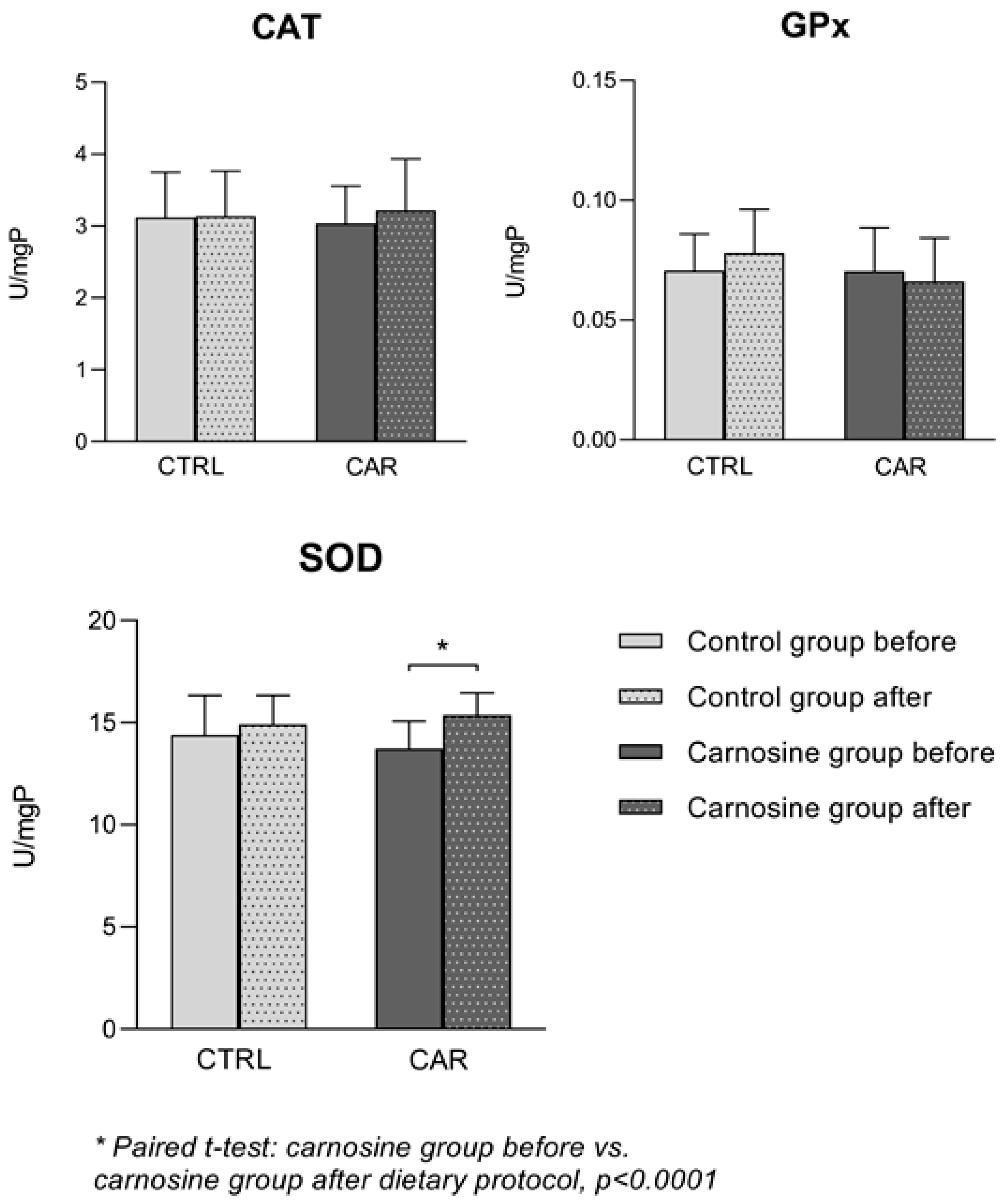
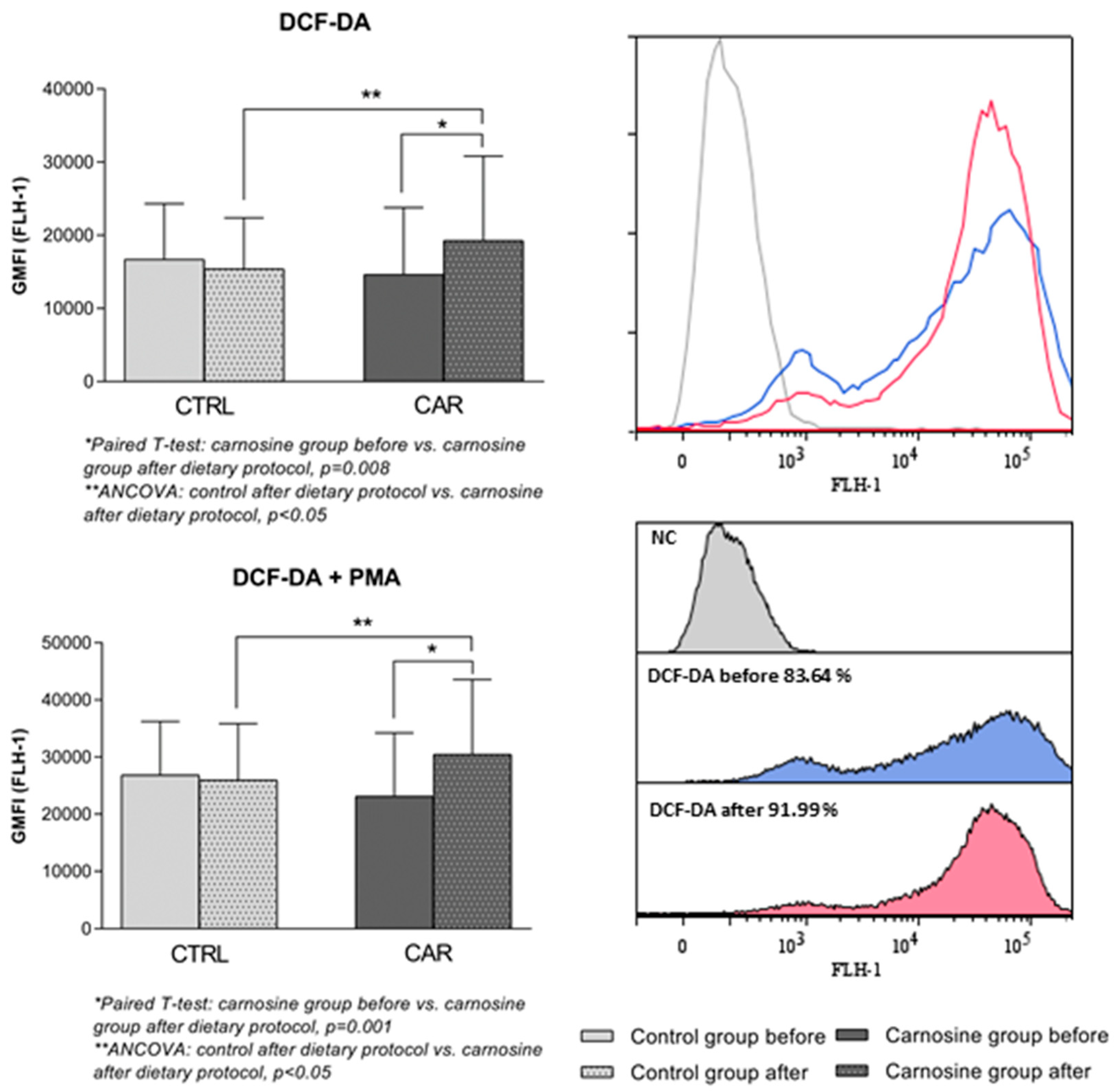
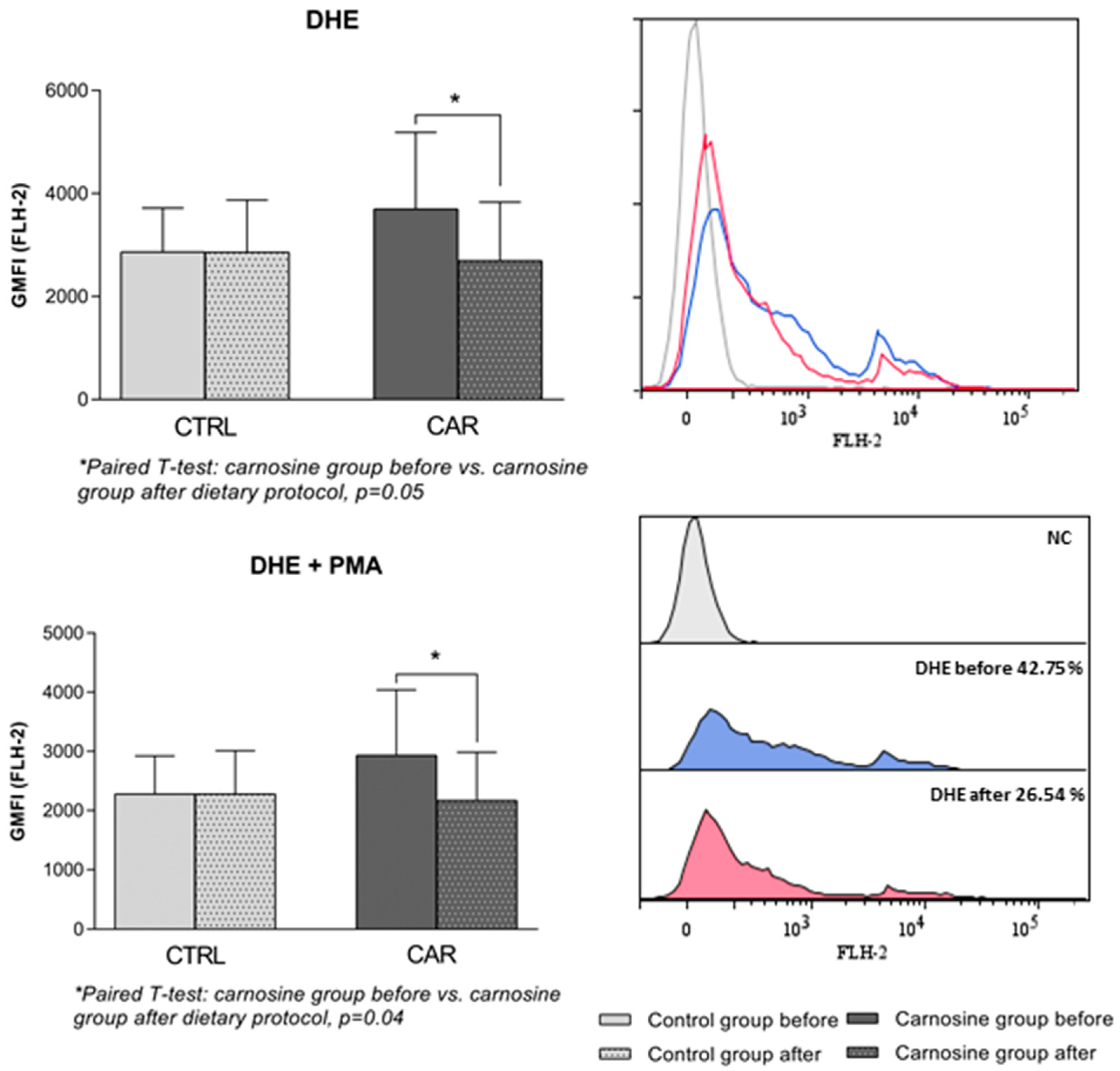
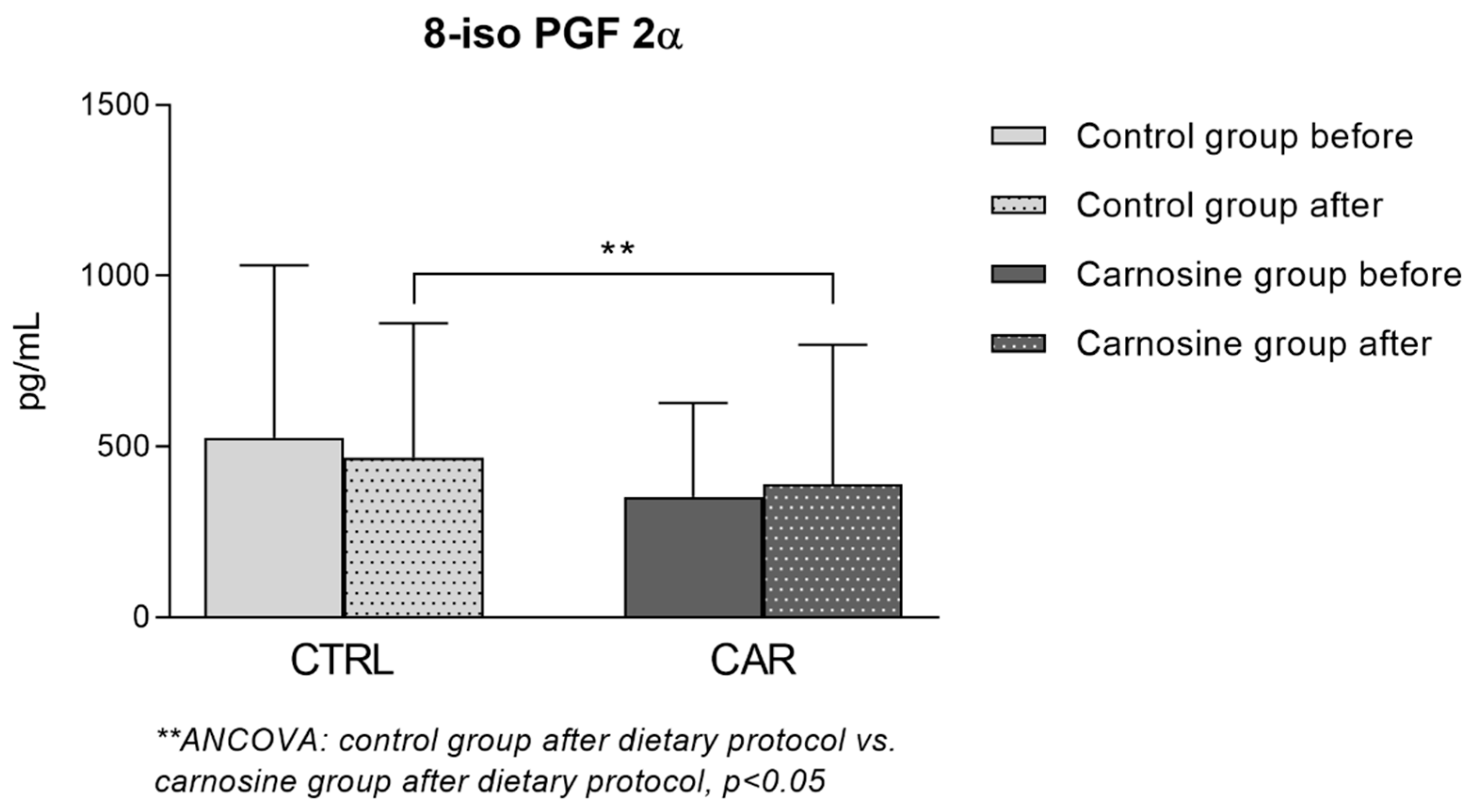
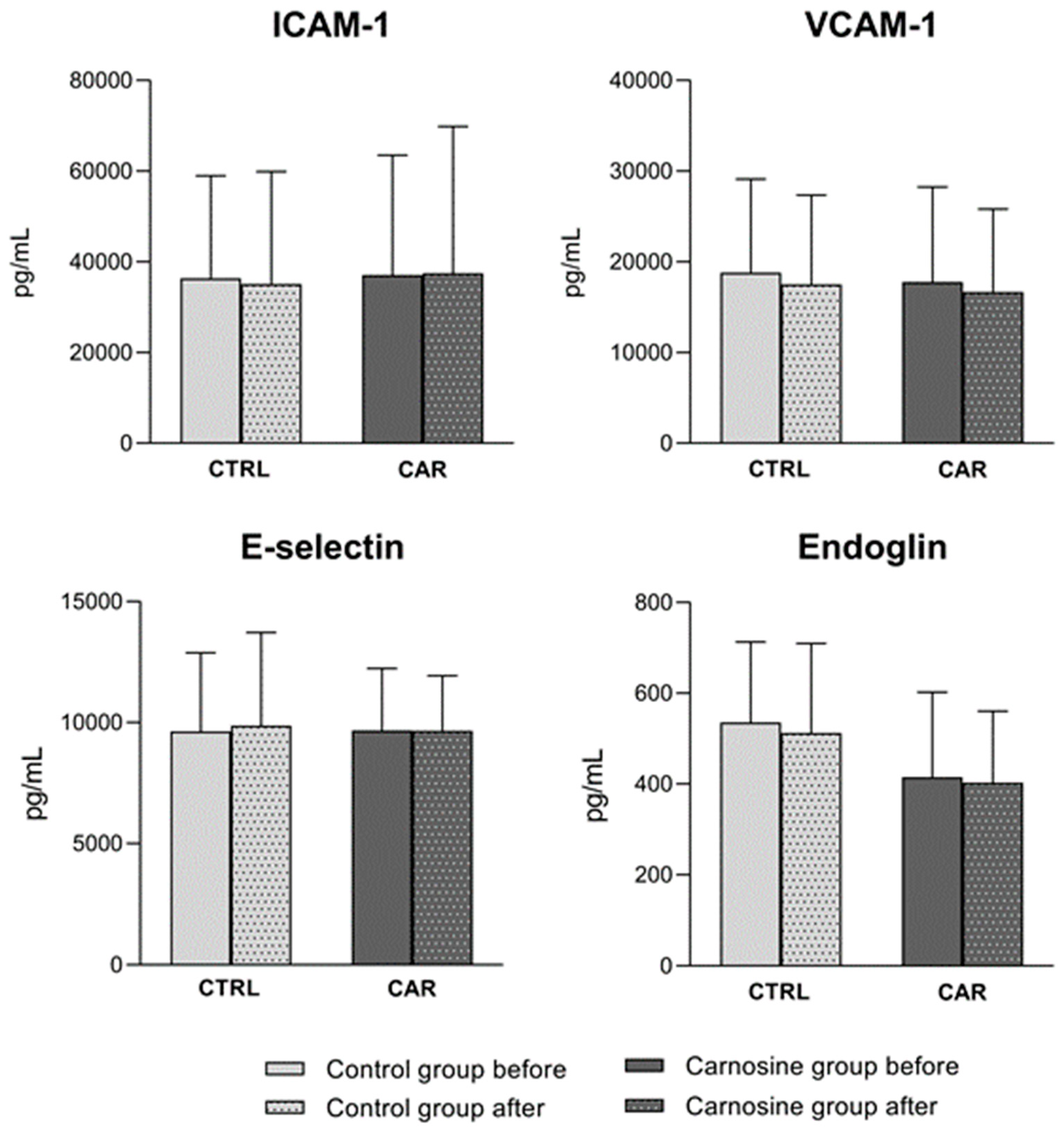
| Parameter | CTRL | CAR | p ‡ | ||||
|---|---|---|---|---|---|---|---|
| N | 16 | 19 | |||||
| Age (years) | 22.6 (5.9) | 22.3 (4.8) | 0.072 | ||||
| Before | After | p † | Before | After | p † | p ‡ | |
| BMI (kg/m2) | 24.5 (2.5) | 24.4 (2.5) | 0.259 | 24.2 (2.0) | 24.2 (1.9) | 0.871 | 0.366 |
| WHR | 0.82 (0.05) | 0.81 (0.04) | 0.382 | 0.82 (0.04) | 0.82 (0.04) | 0.813 | 0.92 |
| Erythrocytes (×1012/L) | 5.2 (0.3) | 5.1 (0.3) | 0.065 | 5.0 (0.3) | 5.0 (0.4) | 0.117 | 0.411 |
| Haemoglobin (g/L) | 150.4 (6.2) | 146.8 (6.9) | 0.03 * | 144.1 (7.3) | 144.4 (10.9) | 0.229 | 0.561 |
| Haematocrit (%) | 0.454 (0.017) | 0.445 (0.023) | 0.035 * | 0.434 (0.021) | 0.440 (0.030) | 0.034 * | 0.425 |
| Leukocytes (×109/L) | 6.6 (1.0) | 5.9 (1.1) | 0.011 * | 6.3 (1.6) | 5.8 (1.3) | 0.155 | 0.716 |
| Thrombocytes (×109/L) | 241.7 (36.2) | 239.2 (36.3) | 0.729 | 227.6 (39.9) | 229.9 (30.2) | 0.726 | 0.75 |
| Transferrin (g/L) | 2.8 (0.3) | 2.7 (0.4) | 0.211 | 2.8 (0.4) | 2.8 (0.4) | 0.712 | 0.448 |
| Glucose (mmol/L) | 4.7 (0.4) | 4.8 (0.4) | 1 | 4.8 (0.4) | 4.8 (0.5) | 0.951 | 0.786 |
| hsCRP (mg/L) | 2.6 (7.5) | 1.6 (3.7) | 0.359 | 1.1 (1.0) | 1.5 (1.9) | 0.839 | 0.97 |
Disclaimer/Publisher’s Note: The statements, opinions and data contained in all publications are solely those of the individual author(s) and contributor(s) and not of MDPI and/or the editor(s). MDPI and/or the editor(s) disclaim responsibility for any injury to people or property resulting from any ideas, methods, instructions or products referred to in the content. |
© 2025 by the authors. Licensee MDPI, Basel, Switzerland. This article is an open access article distributed under the terms and conditions of the Creative Commons Attribution (CC BY) license (https://creativecommons.org/licenses/by/4.0/).
Share and Cite
Kolobarić, N.; Perić, L.; Mihaljević, Z.; Šušnjara, P.; Boris, A.; Drenjančević, I.; Jukić, I.; Stupin, A. Antioxidant Effects of Carnosine-Enriched Chicken Meat Consumption in Athletes: Modulation of SOD Activity and Superoxide Levels—A Randomized Control Trial. Antioxidants 2025, 14, 1069. https://doi.org/10.3390/antiox14091069
Kolobarić N, Perić L, Mihaljević Z, Šušnjara P, Boris A, Drenjančević I, Jukić I, Stupin A. Antioxidant Effects of Carnosine-Enriched Chicken Meat Consumption in Athletes: Modulation of SOD Activity and Superoxide Levels—A Randomized Control Trial. Antioxidants. 2025; 14(9):1069. https://doi.org/10.3390/antiox14091069
Chicago/Turabian StyleKolobarić, Nikolina, Leon Perić, Zrinka Mihaljević, Petar Šušnjara, Alina Boris, Ines Drenjančević, Ivana Jukić, and Ana Stupin. 2025. "Antioxidant Effects of Carnosine-Enriched Chicken Meat Consumption in Athletes: Modulation of SOD Activity and Superoxide Levels—A Randomized Control Trial" Antioxidants 14, no. 9: 1069. https://doi.org/10.3390/antiox14091069
APA StyleKolobarić, N., Perić, L., Mihaljević, Z., Šušnjara, P., Boris, A., Drenjančević, I., Jukić, I., & Stupin, A. (2025). Antioxidant Effects of Carnosine-Enriched Chicken Meat Consumption in Athletes: Modulation of SOD Activity and Superoxide Levels—A Randomized Control Trial. Antioxidants, 14(9), 1069. https://doi.org/10.3390/antiox14091069









